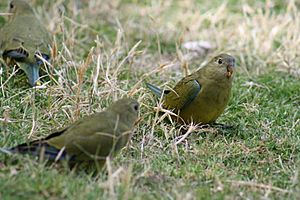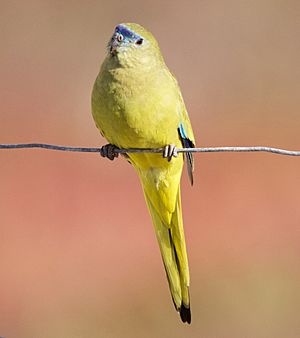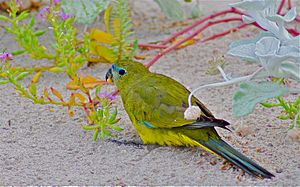Rock parrot facts for kids
The rock parrot (Neophema petrophila) is a small, colorful bird found along the coasts of southern Australia. It was first described by John Gould in 1841. This parrot is about 22 to 24 cm (8+3⁄4 to 9+1⁄2 in) long and weighs around 50–60 g (1+3⁄4–2 oz).
Quick facts for kids Rock parrot |
|
|---|---|
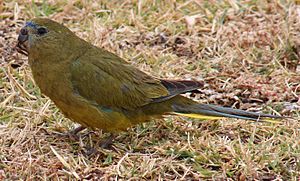 |
|
| At Cape Leeuwin, Western Australia | |
| Conservation status | |
| Scientific classification | |
| Genus: |
Neophema
|
| Species: |
petrophila
|
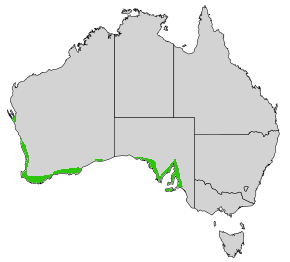 |
|
| Rock parrot range | |
| Synonyms | |
|
Euphema petrophila, Gould, 1841 |
|
Rock parrots have mostly olive-brown feathers on their backs and yellowish feathers underneath. Their heads are olive with light blue on their cheeks and a dark blue band across their forehead. Females look similar but might have a slightly duller blue band.
These parrots love rocky islands and coastal sand dunes. You can find them from Lake Alexandrina in South Australia all the way west to Shark Bay in Western Australia. Unlike other grass parrots, they build their nests in burrows or rocky cracks, often on islands like Rottnest Island. They mainly eat seeds from grasses and other plants. Even though their numbers are going down because of wild animals like cats and foxes, they are currently listed as a "least concern" species by the International Union for Conservation of Nature (IUCN).
Contents
About the Rock Parrot's Name
The rock parrot was first named by an English bird expert, John Gould, in 1841. He called it Euphema petrophila. The name petrophila comes from ancient Greek words: petros meaning 'rock' and philos meaning 'loving'. So, its name means "rock-loving".
Later, in 1891, an Italian expert named Tommaso Salvadori put the rock parrot into a new group called Neophema. This is how it got its current scientific name, Neophema petrophila.
The rock parrot is part of a group of birds called "grass parrots." It is closely related to the orange-bellied parrot. Scientists believe that rock parrots started nesting in burrows to stay safe from animals that hunt in trees.
There are two main types, or subspecies, of rock parrots. One is found in Western Australia, and the other in South Australia.
What the Rock Parrot Looks Like
The rock parrot is a small, slender bird. It measures about 22 to 24 cm (8+3⁄4 to 9+1⁄2 in) long and has a wingspan of 33–34 cm (13–13+1⁄2 in). It weighs around 50–60 g (1+3⁄4–2 oz).
Both male and female rock parrots look quite similar. Their upper bodies, including their heads and necks, are mostly olive-brown. Their undersides are more yellowish. They have a dark blue band across their upper forehead, between their eyes. This band has a thin light blue line above it and a thicker light blue band below it. Their cheeks are also light blue. Female parrots have a slightly duller blue band and less blue on their faces.
Their wings are mostly olive, and when folded, they show a two-toned blue edge. The main flight feathers are black with dark blue edges. Their tails are turquoise with yellow edges. Their chests and bellies are olive-yellow, becoming brighter yellow closer to their tail.
Young rock parrots are a duller, darker olive color. They either don't have the blue forehead band or it's very faint. Their bills are yellowish or orange at first, then turn brown. Young females have light spots on some of their wing feathers. They change their feathers as they grow, looking more like adults when they are about a year old.
It can be tricky to tell a rock parrot apart from other similar parrots like the elegant parrot or blue-winged parrot. These other parrots have brighter olive colors and different blue markings. The orange-bellied parrot is also brighter green.
Where Rock Parrots Live
Rock parrots live along the coast of southern Australia. They are found in two separate areas. In South Australia, they live as far east as Lake Alexandrina. They are more common along the coast of the Gulf St Vincent and on Kangaroo Island. In Western Australia, they live along the southern and western coastlines, reaching up to Shark Bay.
These birds usually stay close to the coast, often within a few hundred meters of the water. They like bare rocky areas or low coastal bushes like pigface and saltbush. You might also find them in sand dunes or salt marshes. They usually avoid farmlands. Rock parrots generally stay in one place, but some might travel up to 160 km (100 mi) after breeding.
Rock Parrot Behavior
Rock parrots are usually seen in pairs or small groups. Sometimes, they gather in larger flocks of up to 100 birds. They might even join groups of elegant or blue-winged parrots. They spend most of their time on the ground, but they will perch on rocks or bushes. They are generally quiet birds. When they fly or eat, they make a soft, two-syllable "zitting" sound. If they sense danger, their alarm call is similar but louder.
Reproduction and Life Cycle
Not a lot is known about how rock parrots breed. They mostly nest on islands off the coast, such as the Sir Joseph Banks Group in South Australia and Rottnest Island in Western Australia. Some nesting has also been seen on the mainland.
Rock parrots stay with the same partner for their whole lives. If one partner dies, the other might find a new mate. They breed from August to December. At the start of the breeding season, males become more active and call more often. The male will try to attract the female by standing tall, bobbing his head, and calling. The female might respond by asking him to feed her, which he does by sharing food he has eaten.
Their nests are hidden under rocks, in cracks, or in burrows. These spots are often covered by plants like pigface. They sometimes use old burrows made by seabirds. Nests are usually well-hidden and hard to reach. They can be 10–91 cm (4–36 in) deep in cracks or 91–122 cm (36–48 in) deep in seabird burrows. Many nests can be found close together in some places.
A female rock parrot lays three to six white eggs. Each egg is about 24 to 25 mm (1.0 in) long. Eggs are laid every two to four days. Sometimes, they might have a second group of chicks if conditions are good. Only the female bird sits on the eggs, which takes 18 to 21 days. The male brings her food during this time.
When the chicks hatch, they are helpless and blind. They have soft, pale grey feathers. Their eyes open around day eight. By day 21, they have good wing and tail feathers. They leave the nest when they are about 30 days old in the wild.
What Rock Parrots Eat
Rock parrots look for food in the early morning and late afternoon. They rest during the hottest part of the day. They usually forage in pairs or small groups, but up to 200 birds might gather where there is a lot of food or water. They mostly find their food on the ground. They are quite calm and will only move a short distance if people get too close.
Rock parrots eat seeds from many different types of plants. These include various grasses like wild oat and wheat, and rushes. They also love seeds from succulent plants like pigface. They eat seeds from daisy plants, including coastal daisybush and capeweed. Other plants they eat include saltbush, peppercress, and various coastal shrubs.
Protecting the Rock Parrot
The International Union for Conservation of Nature (IUCN) says the rock parrot is a species of "least concern." This means it's not in immediate danger of disappearing. However, its total population is slowly getting smaller. The biggest threats to rock parrots are wild animals like cats and foxes, and also climate change.
On Rottnest Island, rock parrots used to be very common. But their numbers dropped a lot, partly because young birds were taken for the pet trade. This trade was stopped in the 1970s. The population on Rottnest Island did not recover well. However, using special nesting boxes and breeding programs has helped their numbers start to rise again.
Like most parrot species, the rock parrot is protected by an international agreement called Convention on International Trade in Endangered Species of Wild Fauna and Flora (CITES). This means it's illegal to buy, sell, or trade wild-caught rock parrots.
Rock Parrots as Pets
Rock parrots are not often kept as pets. There are not many records of them successfully breeding in captivity. Their feathers are not as bright as some other parrots, and they are sometimes seen as quiet and less exciting pets. It can also be hard to tell male and female rock parrots apart without special tests.
If kept as pets, rock parrots do better in groups. They need places to nest that look like natural tree hollows. They should also be fed plants like Mesembryanthemum and Carpobrotus. It's important for them not to eat too many sunflower seeds, as this can make them unhealthy or unable to have babies.
Images for kids
-
Pair of rock parrots at Cape Leeuwin on the grounds of Cape Leeuwin Lighthouse, Western Australia.
See also
 In Spanish: Periquito roquero para niños
In Spanish: Periquito roquero para niños



